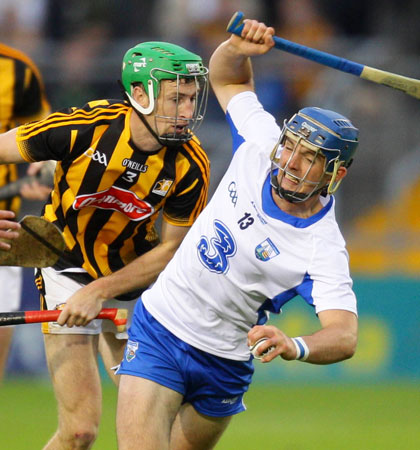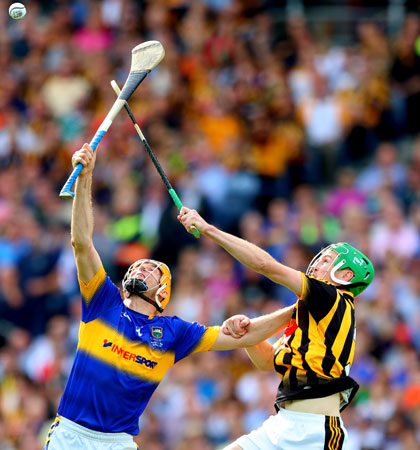FOUR days before the All-Ireland final in September, Seamus Callanan and Eamon O’Shea followed their usual pre-championship match ritual. They met in Semple Stadium.
They talked through different scenarios. Callanan visualised certain outcomes. They did some walk-throughs on movement and positioning, on how, and where, Callanan might attack Kilkenny. Painting pictures, as O’Shea has always termed that process.
They only hit ball for 10 of the 40 minutes they were on the pitch. Callanan even joked to O’Shea on how well he was moving.
They discussed what Kilkenny were likely to do to counteract Callanan, and how his body language and leadership skills would dictate, and control, how the ball was delivered into him.
Practice makes perfect
O’Shea’s coach-player relationship with Callanan has always been about trying to see how far the player could take his excellence.
Before the Munster final in July, they met in the Gaelic Grounds. Prior to the All-Ireland semi-final against Galway, O’Shea and his son Donal met Callanan in Abbotstown. It wasn’t Croke Park but it was close.
To try and counteract Daithi Burke, who is such a good catcher, they focused on stickwork, on Callanan touching the ball one-handed with his hurley to take it away from Burke. They had even practised pushing it forward and then volleying the sliotar.
When Callanan scored his genius fifth point in the final against Kilkenny, touching it away from Joey Holden, and then flicking it into his hand with Kieran Joyce and Paul Murphy converging, it was a play practised in West Dublin four weeks earlier.
Callanan’s performance in the final was the ultimate flowering of his talent but O’Shea was critical to that process.
He had often been approached by former players, and people close to the set-up, and advised to drop Callanan from the panel. They saw him as representative of all that was wrong with the team but O’Shea rehabilitated a genius who had lost his way, his confidence and direction.
Callanan’s rejuvenation was a central story in Tipp’s All-Ireland victory but his team-mates and management constructed the stage and platform for Callanan to display his outrageous gifts.
Against Galway, the ball delivered into the full-forward line was too high, of very poor quality. It allowed Galway to screen Callanan but Tipp needed to attack Kilkenny differently. And they did.
Callanan’s economy was devastating, scoring nine points from just 11 plays. It was the highest individual score from play ever recorded in an All-Ireland final.
Yet for eight of those scores, Callanan was in a one-on-one match-up. Against Joey Holden and Shane Prendergast, there was only going to be one outcome.
Numbers game
Of the 40 balls played into their forward line, Tipp won 24 (60 per cent). From that possession, Tipp directly mined 1-14.
Those are staggering numbers against Kilkenny, especially when contaminating the opposition’s supply lines has been a central component of Kilkenny’s gameplan for a decade.
 Waterford’s Patrick Curran is tackled by Kilkenny’s Joey Holden in the semi-final repaly (Image: inpho.ie)
Waterford’s Patrick Curran is tackled by Kilkenny’s Joey Holden in the semi-final repaly (Image: inpho.ie)Tipp bossed Kilkenny like no team has managed in a decade. Waterford hammered Kilkenny on work rate in the drawn All-Ireland semi-final but they hadn’t enough guns to take them down.
With Tipp working so hard, and generating so much possession, their hardware blew Kilkenny to smithereens.
The physicality in the final was not at the same overall level as the 2010 All-Ireland final, or the 2013 qualifier in Nowlan Park, primarily because Kilkenny brought nowhere near the same intensity.
The 2010 final witnessed the most turnovers-in-possession ever seen in a big hurling game, which Tipp won 15-12. When Kilkenny hounded Tipp into submission a year later, they won that stat 18-3.
In September though, Tipperary won that turnovers-in-possession stat 17-3. What’s more, they scored five points from those turnovers. They also eked out 1-2 from forcing Kilkenny defenders into errors from their incessant heat.
Tipp’s work rate went to a new level. In their seven championship meetings with Kilkenny between 2009-14, their average for turnovers-in-possession was seven. Their average for effective hooks-blocks-tackles was 29. In this year’s final, it was 52.
Kilkenny’s mantra is built on never being outworked. Apart from the 2012 Leinster final, in every other game Kilkenny have lost in the last decade, they have lost the effective hooks-blocks-tackles count.
Losing that stat so badly in September though, forced the Kilkenny half-back line to engage the battle higher up the field, which opened so much space in front of the Tipp full-forward line.
Brian Cody’s record is impeccable but not making a change until the 59th minute was strange when the full-back line was being destroyed and the forward line wasn’t functioning.
Scoring 2-20 in those circumstances is huge testament to Kilkenny’s resolve but not having the same depth or roster of options anymore left them more exposed.
Hurling at a crossroads
 The semi-finals and final of the SHC saw four fantastic games culminating in Tipperary's victory over Kilkenny (Image: inpho.ie)
The semi-finals and final of the SHC saw four fantastic games culminating in Tipperary's victory over Kilkenny (Image: inpho.ie)The outcome was inevitable with 10 minutes remaining but it was still an excellent game. After the drawn and replayed Kilkenny-Waterford games, and the Galway-Tipp semi-final, it was the fourth brilliant match within a month.
By that stage though, the game needed a lift. With so many teams playing sweepers, the hurling public was turning its back on the game.
Hurling was at a crossroads by early August and that increasing disconnect between managers, coaches and players was a key conundrum facing hurling this summer.
The Munster championship was abysmal. Clare, Limerick and Cork completely bombed in the province. Waterford were impressive against Clare but then got torpedoed in the final against Tipp.
The Leinster championship wasn’t much better.
Wexford were atrocious against Dublin. Dublin collapsed in the second half against Kilkenny. Offaly recovered from a disastrous start to their round robin group before losing the Leinster semi-final to Galway by 10 points and their subsequent qualifier to Wexford by eight points.
After all the strides made by Laois in the last couple of years, injuries decimated them but they collapsed, losing to Offaly by 11 points and to Clare by 36 points.
The quality was poor but that trend wasn’t happening in isolation. The Leinster final did produce some high-quality stuff in July but by the end of that month, there had only been one high-profile quality game during the previous two seasons – last year’s Tipperary-Galway All-Ireland semi-final.
That was the great conundrum of hurling’s chasing pack, and of hurling in general. Do you stick to your system, be hard to beat, hang in there for as long as possible, and give yourself a chance down the home straight? Or do you trust your players more and just go for it?
Most of the teams playing an out-and-out sweeper were gone out of the championship by late July, with the exception of Waterford. Their system had taken them so far but could it take them any further?
On the morning of the drawn All-Ireland semi-final, Brendan Cummins made some prescient observations in his column.
“Derek McGrath and Waterford need to change, to redirect and recalibrate the machine,” wrote Cummins. “If they do, and lose going down fighting, McGrath is still on the right track. But if Waterford go all out defensive, and still lose, then McGrath is in big trouble. Why wait? Now is the time.”
Waterford did, and everything changed with it.
Then the hurling summer took off because there had only been sporadic shoots of quality and hope throughout the championship up to that point; Westmeath defeated Offaly for the first time in 40 years; Dublin performed well in Pairc Ui Rinn with a young team; Wexford defeated Cork in the championship for the first time in 60 years.
In the end though, the year belonged to Tipperary. O’Shea had always said to the players that they would win an All-Ireland. It didn’t happen on his watch as manager but the players knew that he wouldn’t rest until this team won an All-Ireland.
Three days after the final, Brendan Maher texted O’Shea. “You can rest now."
O’Shea could. Callanan could. And Tipperary could.
For now.

